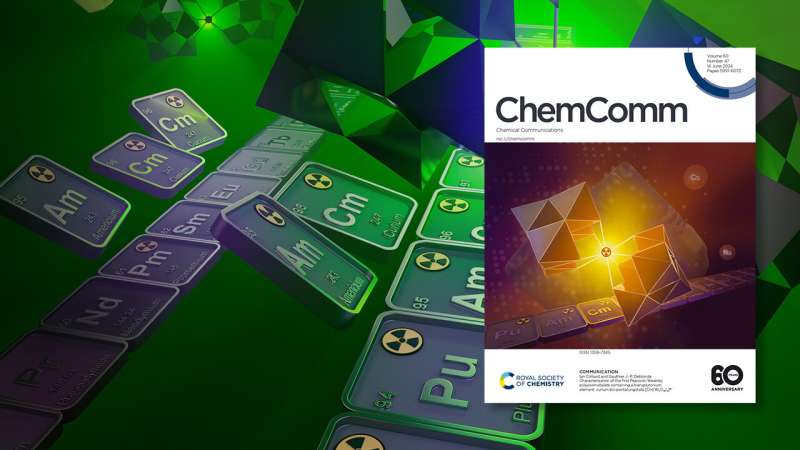This article has been reviewed according to Science X's editorial process and policies. Editors have highlighted the following attributes while ensuring the content's credibility:
fact-checked
peer-reviewed publication
trusted source
proofread
New technique streamlines synthesis of heavy element compounds

Molecular compounds with heavy elements, like americium, curium and others can now be synthesized in a streamlined and efficient way thanks to a new technique developed by Lawrence Livermore National Laboratory (LLNL) researchers.
The new pathway can help scientists perform serial chemistry with radioactive elements and could be used to speed up R&D for nuclear waste management and radiopharmaceuticals. In two articles appearing in Chemical Communications and the JACS Au, LLNL scientists describe how the new technique will lead to innovative ways of separating elements and studying properties of difficult-to-study radioisotopes.
The papers highlight the creation of a large series of new compounds (20 new crystal structures), including the first trivalent americium polyoxometalate compound and two new compounds with curium. Curium has remained an elusive element, with only seven crystal structures of curium molecular compounds reported from its discovery in 1944 to 2020. LLNL scientists discovered five new ones in the past two years.
"We have a new chemical platform to make and study compounds containing pretty much any actinide," said LLNL postdoctoral researcher Ian Colliard, co-author of the papers. "We use a thousand times less materials (micrograms vs. milligrams), so we can go faster, make many more new compounds and it costs less to the Department of Energy."
Scientists know far less about heavy actinides (elements beyond plutonium) than other elements in the periodic table because they are extremely difficult to produce and are both radioactive and toxic. For example, while scientists working on more traditional elements (e.g., iron, copper, lead or gold) can buy an almost limitless quantity of chemicals from many providers for their experiments, actinide chemists can only get a few milligrams per year or less of elements like curium, americium and others.
The source materials are very limited and therefore very expensive (typically more than $50,000 for a few milligrams of curium). These substances also are subject to regulatory approvals since they are nuclear materials and waste from the experiments must be managed properly.
"Using this new chemical platform allows us to go further into the details of actinide chemistry and see things that were not accessible with prior chemical systems and prior synthetic strategies," said LLNL scientist and co-author Gauthier Deblonde. "The new properties we are unlocking, like formation of actinide-specific compounds, will have implications spanning from chemical separations to new radiopharmaceutical drugs and potentially nuclear waste management."
A common method in actinide chemistry has been to simply do experiments with lanthanide surrogates, the non-radioactive elements just above actinides in the periodic table, and consider that actinides would behave the same way. Up to now, there also hasn't been a good system to compare chemical structures of actinide versus lanthanide compounds because experiments could not be done in the same way, or the molecules used would not lead to compounds that could be compared apple-to-apple.
The new research provides an innovative and versatile chemical system where the team synthesized and characterized compounds with americium and curium (actinides) and also the full series of lanthanides (lanthanum to lutetium).
"We obtained a complete and consistent series of compounds so that we could reveal the true impact of actinide vs. lanthanide chemistry," Colliard said. "In this series of approximately 20 new compounds, we observed all complexes have a similar short-range organization, but the long-range organization was really different. This was truly unexpected."
It turned out, the actinides form their own structures—new ones—that were never observed with the lanthanides.
"We provide an unequivocal set of experimental proofs that actinide chemistry cannot be predicted solely based on lanthanide chemistry," Deblonde said. "The results also show a clear fundamental difference between actinide and lanthanide elements, which will lead to new developments in the chemistry of heavy elements, even the rarest ones like actinium, and trans-curium elements."
More information: Ian Colliard et al, Polyoxometalate Ligands Reveal Different Coordination Chemistries Among Lanthanides and Heavy Actinides, JACS Au (2024). DOI: 10.1021/jacsau.4c00245
Ian Colliard et al, Characterization of the first Peacock–Weakley polyoxometalate containing a transplutonium element: curium bis-pentatungstate [Cm(W5O18)2]9−, Chemical Communications (2024). DOI: 10.1039/D4CC01381F
Journal information: JACS Au , Chemical Communications
Provided by Lawrence Livermore National Laboratory



















